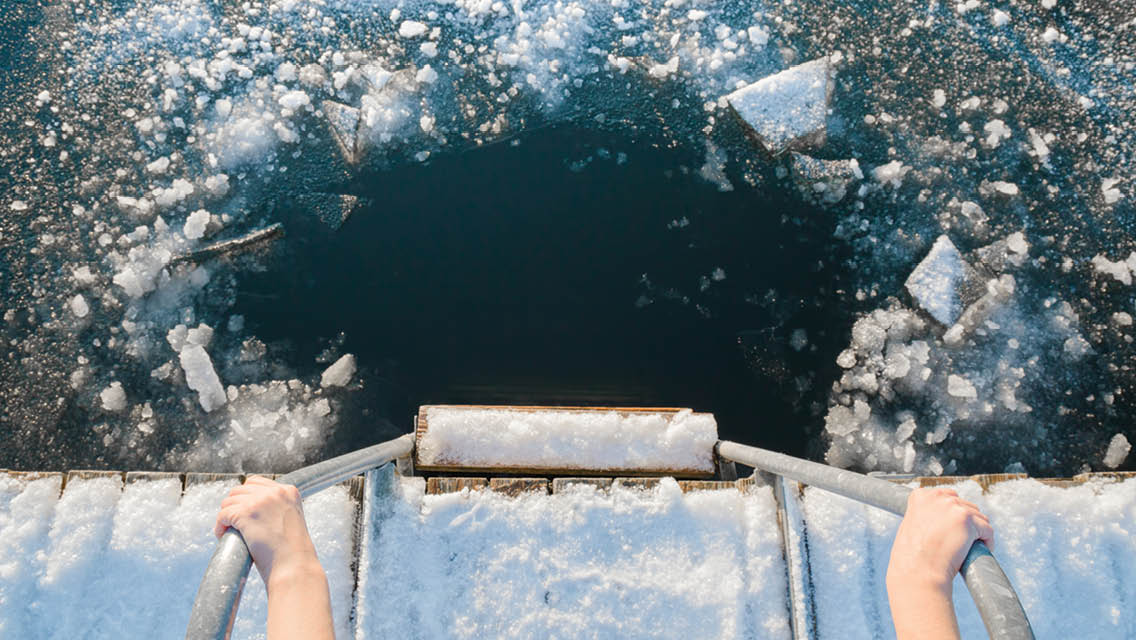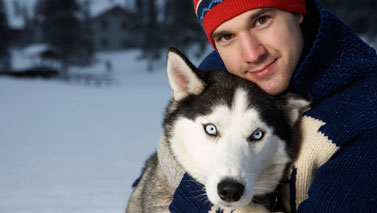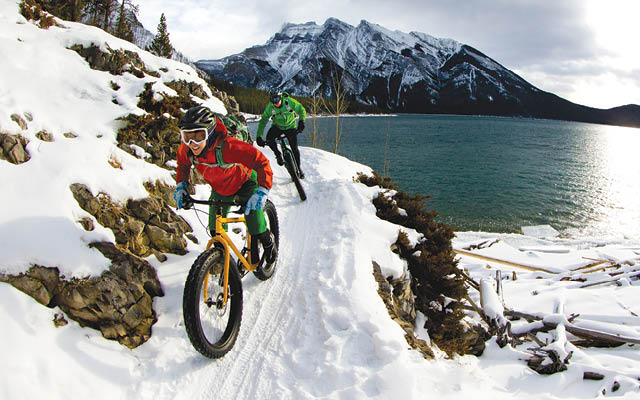Explore how cold conditioning can help your health and well-being:
- How Cold Aids Recovery
- How Cold Exposure Helps Mental Health and Mood
- How Cold Exposure Improves Metabolic Health
- 6 Tips for Building Cold Tolerance
- The Breathwork Technique
- How to Stay Safe In the Cold
Andrea Borgen was born and raised in the upper Midwest, but winter leaves her cold. “My dream is to have a hot tub,” she says.
She began to rethink her aversion to low temperatures on a winter-fleeing road trip to the desert with her husband, where they listened to a podcast extolling the capacity of cold showers to boost resilience.
The guest was Wim Hof, a.k.a. the Iceman, who began taking icy plunges at age 17 and now holds 21 world records related to cold exposure. He attributes his capacities for endurance to his three-part method — exercise, cold therapy, and meditation.
Researchers have studied Hof’s methods to better understand how willpower can affect the body’s thermoregulation system. While athletes have long used cold therapy to treat postgame soreness and injuries, Hof’s followers worldwide have tested its ability to treat a broad variety of ills. Some seek cold therapy to ease chronic conditions like Parkinson’s disease and arthritis; others feel it helps alleviate their burnout. And some simply wish to reclaim what they see as a more vital way of living.
“As humanity has evolved and developed technology that has made us more comfortable, we have lost our innate ability not only to survive but to thrive in extreme environments,” Hof writes in The Wim Hof Method: Activate Your Full Human Potential. “In the absence of environmental stress, the things we have built to make our lives easier have actually made us weaker.”
“In the absence of environmental stress, the things we have built to make our lives easier have actually made us weaker.”
Borgen was intrigued by Hof’s notion that small cold stressors can make us stronger and more resilient. To overcome her resistance, she says, “I began looking at it like I did when I decided to run a marathon.”
She started slowly, “adding 30-second bursts of cold water to the end of my shower.” She gradually increased them to 90 seconds. After a few months, Borgen joined a group of other intrepid souls and broke the ice — literally — by plunging into a Minneapolis lake in February.
“I was able to stay in for two minutes,” she recalls. “It was exhilarating! I came out with a refreshed sense of what I was capable of.”
The benefits of cold conditioning are not new, nor is the appreciation of it limited to Hof and his followers. Cold-water exposure may boost endorphins, which might partially explain why Finland and Denmark — where winter swimming is a popular pastime — consistently rank among the world’s happiest countries.
All to say, cold conditioning offers many potential benefits for both physical and mental well-being, some of which are altogether practical, like becoming more comfortable outdoors during the chillier months. It just may be worthwhile to warm up to the cold.
How Cold Aids Recovery
Knowledge of cold’s analgesic and anti-inflammatory properties dates back to the ancient Egyptians and the Greek physician Hippocrates, but most of us are familiar with cold’s benefits even if we haven’t thought about them as such. If you’ve ever run cold water over a burn, or reached for an ice pack to treat a sprain or strain, you’ve harnessed the healing power of cold.
Here’s partly why it works:
An acute injury, such as a sprained ankle, triggers a process known as secondary cell injury, when the body’s inflammatory response to the primary injury damages intact cells throughout the body. This can decrease blood flow, starving tissues of oxygen and other nutrients, which reduces their function.
When immersive forms of cold therapy or “cryotherapy” are used for sports recovery, they cause vasoconstriction, or the shrinking of blood vessels. The body responds by beginning to shiver, and blood is moved to the core; this is part of a survival mechanism to protect the vital organs. This process bathes the brain and key organs in fresh blood full of nutrients and oxygen.
Warming up from cold exposure promotes vasodilation, or the enlarging of blood vessels, which causes the opposite dynamic. All this circulatory movement helps restore cells after secondary injury.
Ice baths have been shown to decrease pain during recovery from extreme exertion. By quickly lowering body temperature, they also speed recovery: A 2015 meta-analysis of 19 studies found that participants who immersed themselves in water of around 50 degrees F recovered twice as fast as a control group.
How Cold Exposure Helps Mental Health and Mood
Though many people find winter depressing, this is more likely related to lack of light than exposure to the cold, which has the capacity to stabilize mood. Research suggests this may have something to do with the anti-inflammatory effects of cold temperatures, as depression is often associated with excess inflammation.
Studies have shown cold-water immersion to increase levels of the brain’s reward chemical dopamine by 250 percent. One 2018 analysis found that a year of cold-water swimming allowed a chronically depressed woman to wean herself from prescribed antianxiety and depression medications. British researcher Mark Harper, MD, is investigating whether cold-water swimming can help healthcare workers recover from the stress of the coronavirus pandemic.
Studies have shown cold-water immersion to increase levels of the brain’s reward chemical dopamine by 250 percent.
The mental-health benefits accrue in two phases. The first is the momentary shock that triggers the body’s fight-or-flight response. The second comes from a period of adaptation after repeated exposure over time.
Some anecdotes suggest that even cold showers can ease depression. Because the density of cold receptors in the skin is thought to be three to 10 times greater than warm receptors, their simultaneous firing produces a stimulating therapeutic action, explains naturopath Peter Bongiorno, ND, LAc, author of Holistic Solutions for Anxiety and Depression in Therapy.
Cold exposure also helps increase mood-boosting neurotransmitters like norepinephrine, as well as pain-relieving endorphins, he says.
How Cold Exposure Improves Metabolic Health
Norepinephrine also plays a role in the cold-adaptive phase (physical adaptations made by the human body to different environmental conditions) and affects energy reserves. “It is a signaling molecule to basically make more mitochondria,” says biochemist Rhonda Patrick, PhD, who studies the health impacts of cryotherapy on aging. When the body is exposed to cold, norepinephrine signals fat cells to activate the uncoupling protein-1 (UCP1) gene, which in turn triggers an increase in mitochondria production.
The added mitochondria creates more “brown fat” (the more mitochondria a fat cell contains, the browner it looks under a microscope). This fat is then burned for energy to generate heat.
During this adaptive process, the body is also prepping for the next cold blast. With each exposure, and increase in brown-fat production, the body becomes more cold tolerant.
“Activation of brown fat burns calories, improves insulin sensitivity, and even affects appetite regulation.”
A small study in 2014 suggested that increasing brown fat could improve adaptation to colder environments, potentially leading to improved glucose metabolism. For four months, five men slept in rooms with temperatures that varied each month, with the second month being the coldest. After a month of mild cold exposure, and controlling for other factors, researchers found that the participants’ brown-fat volume had increased by 42 percent and their fat-metabolic activity was boosted by 10 percent.
“Activation of brown fat burns calories, improves insulin sensitivity, and even affects appetite regulation,” says University of Copenhagen associate professor Camilla Schéele, PhD, coauthor of an important 2020 brown-fat study. These findings, she says, could be especially useful to people diagnosed with type 2 diabetes or struggling with severe obesity.
6 Tips for Building Cold Tolerance
Challenging our entrenched beliefs about the cold may be the real promise of cold conditioning, whether it helps us adapt for extreme sports, go for a jog in cold weather, or simply pass the winter months with a better mindset.
“If we think we are miserable when we are cold, then we are very likely going to be miserable when we are cold,” says Kenton Whitman, who teaches cold conditioning and other rewilding skills in Wisconsin. “But if we can learn to embrace and adapt to it, then a new world opens up to us.”
These tips can help you begin to improve your cold tolerance:
1) Begin at the end. “Thirty seconds [of cold water] at the end of your shower every day is all it takes at the beginning,” Hof explains. “And in only a few days, you will feel not only able to endure those 30 seconds, but more. This is because the tone of your vascular muscles is improving, developing. Your core body temperature remains just fine.”
The shock, Whitman notes, eventually wears off. “When you begin, even if you take a cool shower, you’re going to have a strong mental and physical reaction if you haven’t done it before,” he says. “When you increase the time you spend gradually, it’ll feel good if you decide to do something like a polar plunge or ice swimming.” (When you’re ready to take that plunge, check out the tips from the Outdoor Swimming Society here.)
2) Turn down the thermostat. One Dutch study suggests that colder ambient temperatures can act as a simple form of cold conditioning. Researchers asked 17 people to spend six hours a day in a temperature-controlled setting of 59 degrees F. After 10 days, participants had higher levels of brown fat and shivered less.
“If I always keep my house at 72 degrees F, the temperature regulation system of my body doesn’t get a chance to work as often,” Whitman explains. He also notes that some research suggests that keeping your bedroom at a colder temperature — between 60 and 67 degrees F — may help you sleep better.
3) Roll down the window. “One thing I like to do in the fall is drive with my window down for part of my trip,” Whitman says. “This is a great way to build your cold resilience because you can always roll your window up and let less air in.” You can also wait to turn on your car’s heater.
4) Step outside. Stand outside your front door in cooler weather for a few minutes before returning inside, and gradually increase the time outside.
5) Dress down. Whether you’re running, walking, biking, ice skating, skiing, or hiking, Whitman suggests wearing one layer less than feels comfortable. “If you step outside and say, ‘This is sweatshirt weather,’ simply tie your hoodie around your waist and start doing your activity,” he advises. “When you begin feeling like it’s just way too cold, you can put on your layer if you need it. But you might start to find that you can go longer and longer without it.”
6) Embrace more outdoor activities. Walking, biking, running, snowshoeing, skiing, sledding, and animal tracking are great ways to enjoy the winter weather and create some positive memories in the cold.
The Breathwork Technique
An essential part of the Wim Hof method for developing cold tolerance is breathing. “The breath is a door,” Hof explains. “It’s where life begins.”
Research on anxiety has shown that controlling one’s breath can modulate the body’s autonomic nervous system, which is the primary mechanism regulating the fight-or-flight response. Hof’s approach is outlined here; use it when you’re preparing for imminent exposure to cold, or when you’re working to improve your cold tolerance overall.
Step 1. Lie down in a quiet, safe environment. Wear something that allows your lungs to expand on the inhale.
Step 2. Close your eyes and clear your mind. Take 30 to 40 deep breaths through your nose or mouth. Imagine you’re filling your body from your belly all the way to your head. Don’t force a large exhale; instead, relax and let it out.
Step 3. At the end of the last breath, inhale once more and fill your lungs without force. Relax and exhale the air. Hold until you feel you need to breathe again — this is what Hof calls the retention phase.
Step 4. When you feel the urge to breathe, take a deep breath and hold it for 10 to 15 seconds. He calls this the recovery breath.
Step 5. Repeat the cycle three to four times.
How to Stay Safe In the Cold
Cold exposure is a powerful experience for the body — but it’s not without some risk. Follow this guidance to stay safe.
Bring warm clothes. Pack a hat, gloves, and scarf when you’re going out in the cold so you have them when you need them. “The idea is to find a little spot and hang out there for a bit — not to endanger yourself,” says rewilding teacher Kenton Whitman. “Approach it like you would doing a yoga pose.”
Respect your limits. Listen to your body when approaching cold conditioning. If you have had frostbite previously or experience Raynaud’s phenomenon (a circulatory syndrome affected by cold) or have serious issues with your heart or lungs, check with your physician before trying it.
Use a scarf to protect your lungs. Even if you’re deliberately exposing your body to cold, the lungs still do best with warm air. The American Lung Association recommends loosely wrapping a scarf across your nose and mouth to warm the air before it enters your lungs. Breathe in through your nose and out through your mouth.
Know the signs of frostbite. If you feel pins and needles, experience numbness in a particular area, or notice hard and pale skin, you may have developed frostbite. “It’s imperative to pay attention to your extremities, like hands and feet,” Whitman adds.
Hydrate. “Mountaineers and mountain-rescue groups will tell you that staying hydrated is one of the most important aspects of their cold-adapting process,” he notes. “Whenever we are doing something to test our body, we want to make sure it’s in an optimal state.”
This article originally appeared as “Chill Out” in the October 2021 issue of Experience Life.





This Post Has 0 Comments